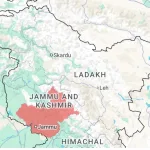CULTURE
The rearing of livestock (raising animals) in Kokarmor was in vogue from remote past in Kashmir. In almost every household across the region, Kokarmor was built under the Veranda of the house, locally known as Brandh (the most suitable place for it). There were many reasons behind its building under the Brandh. Not only would it make easy for the family to feed the livestock during unfavorable weather but it would also protect the stock from the ferocious carnivorous animals that would often loiter in the area during winters to hound birds. One hunting animal, we all would have heard of was wolf, locally called Laeesh (the member of dog family). Keeping Kokarmor under Brandh would also make easy to either fetch eggs or catch the bird for meat while a guest arrived at home.
Not only symbolized ‘Kokarmor’ our culture but it was also an apotheosis of many things in the artistic wonders of village life. Early morning, when the door of Kokarmor was set open to let the whole livestock come out for feeding in the courtyard; elderly would start counting and felt proud of while children remained busy in collecting eggs out from the hencoop. Those days, people raised animals with utmost love and care and often referred it as their “maal” (the asset). They believed that a person without livestock is like a lamb without fur.
It was made sure that the entire livestock of poultry was okay and safely fed. Everyone’s eye would stick at Kokur (the rooster), the king of Kokarmor, love-fully known as Baang-e-Kokur. Mostly loved by elders at our edifices those days, ‘Baang-e-Kokur’ (crowing rooster) was raised for many reasons. And one of the main reasons to rear him out was to give Baang, i.e. to wake up people by crowing for offering Fajr Namaz (dawn prayers). Elders also called Kokur as Aarsh-e-Aala Kokur (the one who informed them that darkness has dispelled and noor/gash has overpowered everything). Besides, giving “baang”, this Kokur was also reared for breeding (copulation) to enhance the stock.
In every household, ‘Baang-e-Kokur’ was grown up with utmost care. People felt pride, not only that the domestic fowl would wake them up for prayers but they would wait much eagerly for the time to come when their Baang-e-Kokur would defeat the neighbor’s Kokur in Kokar Jung (cock fight). This would swell their chest.
‘Baang-e-Kokur’ was also taken to the nearest shrine and offered to the mystic as a gift of submission, faith and respect. It was called Astan Kokur (the one meant for the shrine) and considered most auspicious. Devotees would either set free the male-bird in the shrine premises or cook it at home in the shape of Koker Tahaer ( tahari made up of yellow fried rice mixed with chicken) which was later distributed among children by resh baaye (a disciple woman) at the shrine’s entrance.
‘Baang-e-Kokur’ had Mawal (rooster wattle/ cockscomb) and crowed Kokuruku, and was offered everywhere then, what perhaps made popular Kashmiri poet & humorist, Ayoub Sabir to compose a funny poem entitled as “Kokur”. When Koker (hen) would hatch out chicks, one chick was in prior intended to be offered at the nearest shrine. And when the chick grew into a big Kokur (domestic cock); it was (out of faith) offered as Sadqah (charity) at the shrine. I recall an incident when Mouj (my beloved grandmother whom every one knew as Zoon Ded) took me along with my parents to the holy shrine of Baba Shukr-u-din Wali (RA) where she had to offer Baang-e-Kokur as a gift of gratitude and thankfulness to the Sufi saint.
“Baang-e-Kokur was a token of love & reverence to the Walis (RA) during their Urs, jointly stand for Shashbuk (six famous shrines of the valley like Ameer Kabeer Saeb (RA), Makhdoom Saeb (RA), Dastageer Saeb (RA), Naqashband Saeb (RA), Alumdar-e-Kashmir Saeb (RA) & Baba Reshi Saeb (RA); besides cooked during social functions like Neyaz (feast), Bhandar (community feast), etc. The whole cultural ethos has got disturbed now”, noted poet Zareef Ah. Zareef regretted.
(Author is columnist from Rafiabad. Feedback: [email protected])





